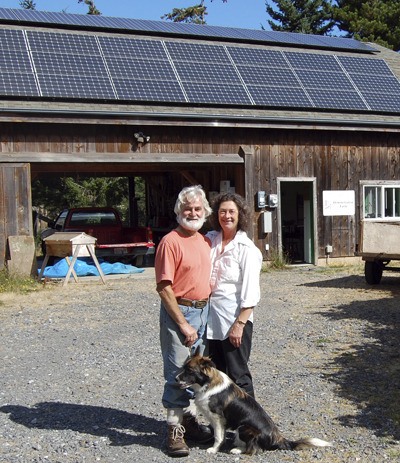Henning Sehmsdorf and Elizabeth Simpson produce everything they need including electricity to sustain their 50-acre farm. In 1970, Sehmsdorf purchased the first 10 acres of his farmland on Lopez Island and created a 50-year plan for a bio-dynamic and sustainable farm. The vision is to produce all food, feed, seeds, animal replacements, timber/lumber, water and energy necessary to sustain the farm and the people who live there. In late 2011, the final piece of the farm plan was implemented: self-sustaining energy.
Sehmsdorf and Simpson worked with OPALCO’s Member Owned Renewable Energy Program and Whidbey Sun and Wind to install a 74-panel photovoltaic system with a nameplate capacity of 16 kilowatts. As of mid-September, about nine months into the first year of production, the system has already produced 15,860 kilowatt-hours.
OPALCO’s MORE Program collects voluntary donations from co-op members on their monthly electric bills to support MORE producers, like S&S Homestead Farm, with annual incentives based on the total amount of energy they produce. An independent committee of OPALCO co-op members manages the process and approves MORE Producer applications and incentives. In addition to local MORE incentives, there are state and federal tax incentives, rebates and credits available.
“Elisa Howard at OPALCO and the engineers at Whidbey Sun and Wind were very good in helping us to understand this complex system and the net metering structure,” said Sehmsdorf, adjunct professor with Washington State University’s Center for Sustaining Agriculture and Natural Resources, and a full-time farmer since 1994.
In planning this project, Sehmsdorf and Simpson set out to reduce the farm consumption by half and produce as much electricity as possible. To reduce consumption, they replaced their home’s electric floor heating system with a very efficient woodstove. They also de-activated a less efficient fireplace insert and replaced incandescent bulbs with CFLs. The fuel for the woodstove is realized from their own by-product supplies of waste lumber and timber from the farm. They have been able to meet the farm’s consumption needs with their PV system since May and the net surplus in energy production is stored on OPALCO’s grid, banked as a credit and paid out each year in April.
“Debt has no place in the farm plan,” said Sehmsdorf, which is why it took them nearly 42 years to realize the energy piece of the plan.
The initial investment of about $86,000 was paid in cash. S&S Homestead Farm received their first MORE producer incentive of $2,935 in August (plus the Washington state incentive of $1,468) and expects to receive a total of $33,389 in combined incentives and tax rebates/credits in 2012. Sehmsdorf has calculated a complete return on investment over ten years, which is much shorter than most systems because of the lack of debt service.
“The annual financial return is about 9.5 percent,” said Sehmsdorf, “better than the stock market or any other investment today. But, when you consider only the financial benefits, you are missing the point.”




